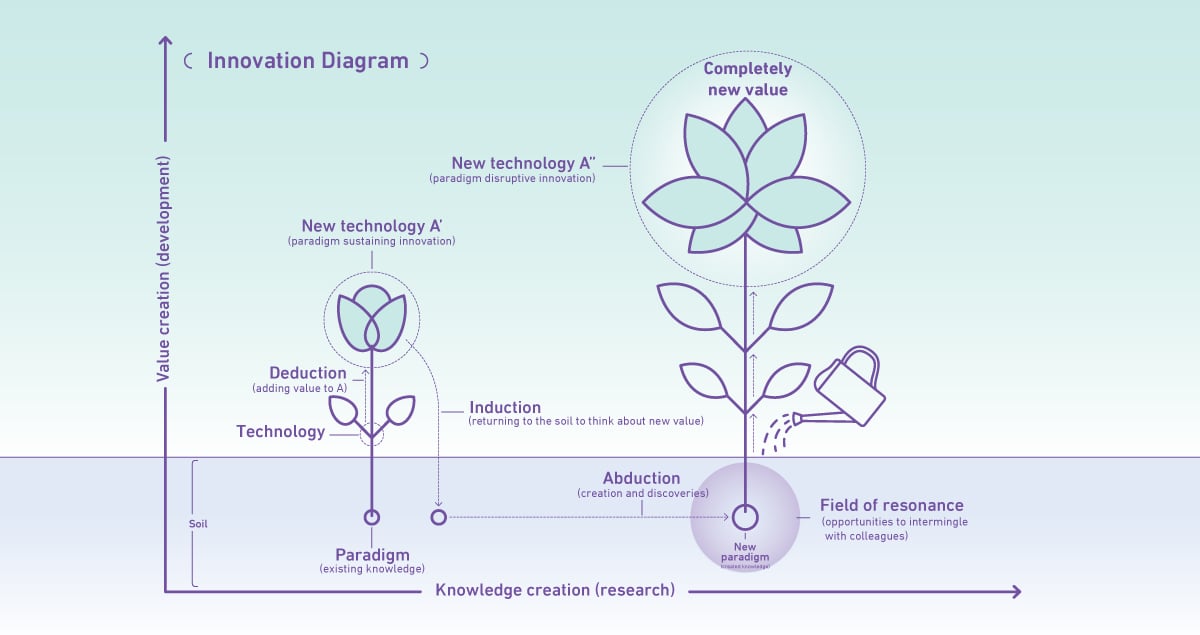Innovation requires a rich foundation and a place of resonance

Japan’s companies have ceased to innovate
— First, please define innovation for us.
The standard definition is “any change that produces social or economic value.” Many people associate innovation with technological changes, but that’s not always the case. The economist Joseph Schumpeter divided innovation into two categories:
Technological innovation
Developing new products, new levels of quality, or new production methods.
Managerial innovation
Opening new markets, acquiring new supply sources, or realizing new organizations. In addition to the above, I advocate a third type called “sensibility innovation.” This type of innovation produces elements like branding and trust that improve value and customer disposition simply through their existence. Modern innovation is the combination of these three types.
— Why is innovation so important for companies?
Innovation is the lifeblood of a company. A company that doesn’t innovate will only regress. It cannot continue indefinitely.
Present day Japan might be compared to a sinking ship. Japan was formerly described as a technological powerhouse, but now it lags behind countries like China and Korea. Our companies have lost their competitive edge. One of the major reasons for this is that they have ceased to innovate technologically. And the reason for this lack of technological innovation is negligence of basic research.
Up until the early 90s, many Japanese companies placed considerable emphasis on basic research. In the 80s and 90s, Japan was on the cutting-edge of science and technology. So much that the US and other countries sought to learn from Japan’s R&D systems. However, this situation took a turn for the worse during the latter half of the 90s. Management began seeing research institutes as cost centers that racked up bills but created no products. Many companies closed down their research institutes and withdrew from basic research. Almost 20 years have passed since then, and those companies have stopped producing new paradigms (principles on which to base our worldviews). That is present day Japan.
Science leads to new value
— Well then, how can we innovate?
Innovation is produced through a chain reaction of knowledge creation and value creation. Knowledge creation refers to learning something previously unknown, seeing something never seen before, or bringing something new into the world. These advances in science require research.
Value creation is the process by which the fruits of knowledge creation are combined to form something of economic or social value. You might call this the “development process” for producing value.
So, how does knowledge creation—“science”—lead to value creation? Please take a look at the image on the right. This innovation diagram is a model of humanity’s scientific pursues. It represents the chain reaction between knowledge creation and value creation that leads to innovation. Knowledge creation is on X-axis. Value creation is on the Y-axis. The horizontal line represents the surface of what we might call “the soil of science.” The plant that grows from this soil is innovation.
Knowledge creation takes place completely within the soil. Researchers are like explorers wandering around in the dark, without even a candle to light their way. Above the soil is the world of sunlight. When created knowledge sprouts from the soil, or in other words, when it becomes a new product or service, it produces specific value for society. The innovations that lead to breakthroughs are a result of the research and knowledge creation that is constantly happening underground. However, people walking on the surface can’t see into the soil. In the same way, management can’t always see the value of a company’s research. That lack of visibility is what led to some companies abandoning or downsizing their basic research during the latter half of the 90s.

Let’s follow the actual process of innovation generation. The changes begin with Existing Technology A, which is based on an existing paradigm. New product development leads to modifications that add value to A (A » A’). This process is called “deduction,” and A’ is a result of “paradigm sustaining innovation.” However, there is a limit to this kind of growth. New Technology A’ is still based on existing technology, so it can be easily imitated. This means that it’s not possible to maintain a competitive edge with this kind of innovation.
However, if the soil is rich, we can temporarily return to it and use the process of induction to consider what the world really needs. Then, through abduction, new knowledge is created. As a result, a previously unfathomed new paradigm is born. From this new paradigm, value is created, leading to New Technology A”. Thus, through the cycle of induction » abduction » deduction that happens within the soil, we see “paradigm disruptive innovation” that leads to a major breakthrough.
A Place of exchange can accelerate innovation
— What kind of environment facilitates innovation?
First, basic research produces rich soil. Another important factor is whether or not there’s a “field of resonance.” This refers to a physical place where knowledge creators and value creators can acknowledge each other’s differences and work together in resonance.
Knowledge creation is solitary work. The creation of a single new paradigm requires many years of silent research. However, the value creation process requires colleagues. The research department and development department must get together, bounce ideas off each other, and communicate to create value. Furthermore, when it comes to commercializing the product, a successful launch requires a variety of different professionals brainstorming together.
I believe that a major problem with Japanese companies is their lack of communication. This is true for internal communication and even more so for external communication. At Silicon Valley in the US, there are places where researchers from different companies can get together and exchange information in the evening. That is the true source of Silicon Valley’s strength. We don’t have anything like that in Japan.
Previously, I did an employee motivation survey for a company in Kyoto. Through this survey, I discovered that communication with people outside of the company is an important factor that leads to higher motivation. Without a doubt, exchanges that transcend company boundaries motivate researchers and stimulate innovation. We need this sort of place of resonance in Japan, and companies need to help.
— What can people who aren’t in R&D do to contribute to innovation?
They should work toward the sensibility innovation that I mentioned earlier. We need them to build trusting relationships and create places of resonance with customers, so that we can work together to create new value.
There’s one more thing I’d like to add here. In many companies, people on the administrative side take no interest in technology, and the people in technical roles don’t attempt to educate them. This is not good. These two groups should be able to discuss technology in common terms. The administrative staff should make an effort to understand the basics of their company’s technology, and the technical staff have an obligation to explain these basics in an easy-to-understand manner. These two groups also need a place of resonance. True innovation is more likely to happen in a company than a university. That’s because companies have a wide range of human resources who are equipped to turn innovation into products, from the R&D stage to procurement and sales.

MHI Group has rich soil
— Lastly, could you give us a message for MHI Group?
I keep a close watch on how much emphasis major Japanese companies place on basic research. While many other companies have closed down their laboratories or cut budgets, MHI Group has continued to conduct basic research without interruption. I believe some of your researchers are working on phenomenal projects that will shake up the industry. That’s very rare among companies these days, and that’s why I have the utmost respect for MHI Group.
Companies like MHI Group who are continuously conducting basic research should have the power to innovate. However, the era of companies conducting research on their own has already ended. It’s essential to keep an eye on the research of other institutions and venture companies. You need to see what kind of paradigms they’re producing and consider how those paradigms might be combined with your own research. I believe that this will be a major function of research institutes in the future.
In the process of value creation, you’ll almost certainly get stuck at some point. When that happens, return to the soil or reach over a boundary. Doing so requires courage. However, without these steps, you won’t be able to create paradigm disruptive innovation.The expression “disrupting paradigms” might be interpreted as something grand or dramatic, but opportunities to do so lie within your day-to-day activities. Please pay attention to flashes of inspiration. A sense of something being out of place often leads to a new road opening up.





